Toyota RAV4 (XA40) 2013-2018 Owners Manual: Engine compartment
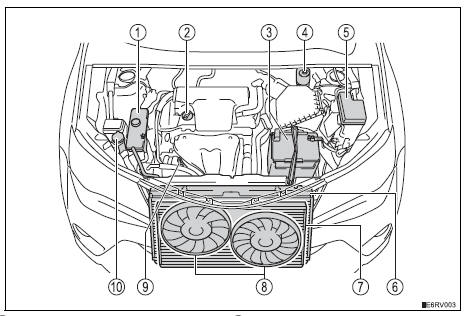
- Engine coolant reservoir
- Engine oil filler cap
- Battery
- Brake fluid reservoir
- Fuse box
- Radiator
- Condenser
- Electric cooling fans
- Engine oil level dipstick
- Washer fluid tank
Engine oil
With the engine at operating temperature and turned off, check the oil level on the dipstick.
Checking the engine oil
- Park the vehicle on level ground. After warming up the engine and turning it off, wait more than 5 minutes for the oil to drain back into the bottom of the engine.
- Holding a rag under the end, pull the dipstick out.
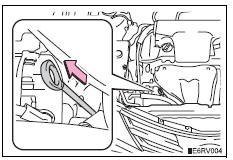
- Wipe the dipstick clean.
- Flat dipstick: reinsert the dipstick fully.
Non-flat dipstick: reinsert the non-flat dipstick fully with its protruding areas ( in the illustration) pointing towards the engine.
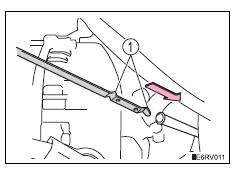
- Holding a rag under the end, pull the dipstick out and check the oil level.
- Low
- Normal
- Excessive
Flat dipstick
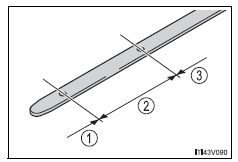
Non-flat dipstick
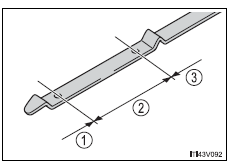
The shape of the dipstick may differ depending on the type of vehicle or engine.
- Wipe the dipstick and reinsert it fully.
Adding engine oil
If the oil level is below or near the low level mark, add engine oil of the same type as that already in the engine.
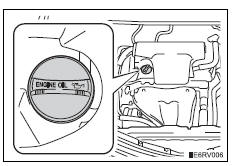
Make sure to check the oil type and prepare the items needed before adding oil.

- Remove the oil filler cap by turning it counterclockwise.
- Add engine oil slowly, checking the dipstick.
- Install the oil filler cap by turning it clockwise.
Engine oil consumption
A certain amount of engine oil will be consumed while driving. In the following situations, oil consumption may increase, and engine oil may need to be refilled in between oil maintenance intervals.
- When the engine is new, for example directly after purchasing the vehicle or after replacing the engine
- If low quality oil or oil of an inappropriate viscosity is used
- When driving at high engine speeds or with a heavy load, when towing, or when driving while accelerating or decelerating frequently
- When leaving the engine idling for a long time, or when driving frequently through heavy traffic
Caution
Used engine oil
- Used engine oil contains potentially harmful contaminants which may cause skin disorders such as inflammation and skin cancer, so care should be taken to avoid prolonged and repeated contact. To remove used engine oil from your skin, wash thoroughly with soap and water.
- Dispose of used oil and filters only in a safe and acceptable
manner. Do
not dispose of used oil and filters in household trash, in sewers or onto
the
ground.
Call your toyota dealer, service station or auto parts store for information concerning recycling or disposal.
- Do not leave used engine oil within the reach of children.
Notice
To prevent serious engine damage
Check the oil level on a regular basis.
When replacing the engine oil
- Be careful not to spill engine oil on the vehicle components.
- Avoid overfilling, or the engine could be damaged.
- Check the oil level on the dipstick every time you refill the vehicle.
- Be sure the engine oil filler cap is properly tightened.
Engine coolant
The coolant level is satisfactory if it is between the “full” and “low” lines on the reservoir when the engine is cold.
- Reservoir cap
- “Full” line
- “Low” line
If the level is on or below the “low” line, add coolant up to the “full” line.
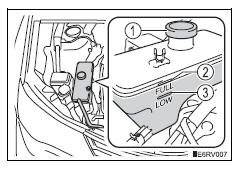
Coolant selection
Only use ¢Â§toyota super long life coolant¢¸ or a similar high quality ethylene glycol based non-silicate, non-amine, non-nitrite, and non-borate coolant with long-life hybrid organic acid technology.
U.S.A.: ¡Â§Toyota super long life coolant¢¸ is a mixture of 50% coolant and 50% deionized water. (Minimum temperature: -31„af [-35„ac]) canada: ¢Â§toyota super long life coolant¢¸ is a mixture of 55% coolant and 45% deionized water. (Minimum temperature: -44„af [-42„ac]) for more details about coolant, contact your toyota dealer.
If the coolant level drops within a short time of replenishing
Visually check the radiator, hoses, engine coolant reservoir cap, drain cock and water pump.
If you cannot find a leak, have your toyota dealer test the cap and check for leaks in the cooling system.
Caution
When the engine is hot
Do not remove the engine coolant reservoir cap.
The cooling system may be under pressure and may spray hot coolant if the cap is removed, causing serious injuries, such as burns.
Notice
When adding coolant
Coolant is neither plain water nor straight antifreeze. The correct mixture of water and antifreeze must be used to provide proper lubrication, corrosion protection and cooling. Be sure to read the antifreeze or coolant label.
If you spill coolant
Be sure to wash it off with water to prevent it from damaging parts or paint.
Radiator and condenser
Check the radiator and condenser and clear away any foreign objects.
If either of the above parts is extremely dirty or you are not sure of their condition, have your vehicle inspected by your toyota dealer.
Caution
When the engine is hot
Do not touch the radiator or condenser as they may be hot and cause serious injuries, such as burns.
Brake fluid
Checking fluid level
The brake fluid level should be between the “max” and “min” lines on the tank.
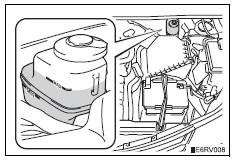
Adding fluid
Make sure to check the fluid type and prepare the necessary item.

Brake fluid can absorb moisture from the air
Excess moisture in the brake fluid can cause a dangerous loss of braking efficiency.
Use only newly opened brake fluid.
Caution
When filling the reservoir
Take care as brake fluid can harm your hands and eyes and damage painted surfaces.
If fluid gets on your hands or in your eyes, flush the affected area with clean water immediately.
If you still experience discomfort, see a doctor.
Notice
If the fluid level is low or high
It is normal for the brake fluid level to go down slightly as the brake pads wear out or when the fluid level in the accumulator is high.
If the reservoir needs frequent refilling, there may be a serious problem.
Battery
Check the battery as follows:
Battery exterior
Make sure that the battery terminals are not corroded and that there are no loose connections, cracks, or loose clamps.
- Terminals
- Hold-down clamp
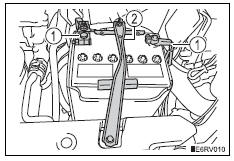
Before recharging
When recharging, the battery produces hydrogen gas which is flammable and explosive. Therefore, before recharging:
- If recharging with the battery installed on the vehicle, be sure to disconnect the ground cable.
- Make sure the power switch on the charger is off when connecting and disconnecting the charger cables to the battery.
After recharging/reconnecting the battery (vehicles with a smart key system)
The engine may not start. Follow the procedure below to initialize the system.
- Shift the shift lever to p.
- Open and close any of the doors.
- Restart the engine.
- Unlocking the doors using the smart key system may not be possible immediately after reconnecting the battery. If this happens, use the wireless remote control or the mechanical key to lock/unlock the doors.
- Start the engine with the engine switch in accessory mode. The engine may not start with the engine switch turned off. However, the engine will operate normally from the second attempt.
- The engine switch mode is recorded by the vehicle. If the battery is reconnected, the vehicle will return the engine switch mode to the status it was in before the battery was disconnected. Make sure to turn off the engine before disconnect the battery. Take extra care when connecting the battery if the engine switch mode prior to discharge is unknown.
If the engine will not start even after multiple attempts, contact your toyota dealer.
Caution
Chemicals in the battery
A battery contains poisonous and corrosive sulfuric acid and may produce hydrogen gas which is flammable and explosive. To reduce the risk of death or serious injury, take the following precautions while working on or near the battery:
- Do not cause sparks by touching the battery terminals with tools.
- Do not smoke or light a match near the battery.
- Avoid contact with eyes, skin and clothes.
- Never inhale or swallow electrolyte.
- Wear protective safety glasses when working near the battery.
- Keep children away from the battery.
Where to safely charge the battery
Always charge the battery in an open area. Do not charge the battery in a garage or closed room where there is not sufficient ventilation.
How to recharge the battery
Only perform a slow charge (5 a or less). The battery may explode if charged at a quicker rate.
Caution
Emergency measures regarding electrolyte
- If electrolyte gets in your eyes
Flush your eyes with clean water for at least 15 minutes and get immediate medical attention. If possible, continue to apply water with a sponge or cloth while traveling to the nearest medical facility.
- If electrolyte gets on your skin
Wash the affected area thoroughly. If you feel pain or burning, get medical attention immediately.
- If electrolyte gets on your clothes
It can soak through clothing on to your skin. Immediately take off the clothing and follow the procedure above if necessary.
- If you accidentally swallow electrolyte
Drink a large quantity of water or milk. Get emergency medical attention immediately.
Notice
When recharging the battery
Never recharge the battery while the engine is running. Also, be sure all accessories are turned off.
Washer fluid
If any washer does not work or the low washer fluid warning light comes on, the washer tank may be empty. Add washer fluid.
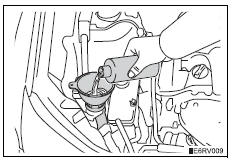
Caution
When adding washer fluid
Do not add washer fluid when the engine is hot or running as washer fluid contains alcohol and may catch fire if spilled on the engine etc.
Notice
Do not use any fluid other than washer fluid
Do not use soapy water or engine antifreeze instead of washer fluid.
Doing so may cause streaking on the vehicle’s painted surfaces.
Diluting washer fluid
Dilute washer fluid with water as necessary.
Refer to the freezing temperatures listed on the label of the washer fluid bottle.
 Positioning a floor jack
Positioning a floor jack
When raising your vehicle with a floor jack, position the jack correctly.
Improper placement may damage your vehicle or cause
injury.
Front
Rear
Caution
When raising your vehicle
Make ...
 Tires
Tires
Replace or rotate tires in accordance with maintenance schedules
and treadwear.
Checking tires
New tread
Treadwear indicator
Worn tread
The location of treadwear indicators
is shown ...
Other materials:
Front passenger airbag assembly
Components
On-vehicle inspection
Check front passenger airbag assembly (vehicle not involved in
collision and airbag not deployed)
Perform a diagnostic system check (see page rs-
49).
With the front passenger airbag installed on the
vehicle, perform a visual check:
chec ...
High beam automatic turning on or off conditions
When all of the following conditions are fulfilled, high beam will be
automatically turned on:
Vehicle speed is above approximately 21 mph (34 km/h).
The area ahead of the vehicle is dark.
There are no oncoming or preceding vehicles with headlights or tail
lights turned on.
There are fe ...
Heated steering wheel/seat
heaters/seat ventilators
Heated steering wheel
Warm up the grip of the steering
wheel
Seat heaters
Warm up the seat upholstery
Seat ventilators
Maintain good ventilation by
pulling air through the seat
upholstery
WARNING
â– To prevent minor burn injuries
Care should be taken if anyone in
the following categories ...
